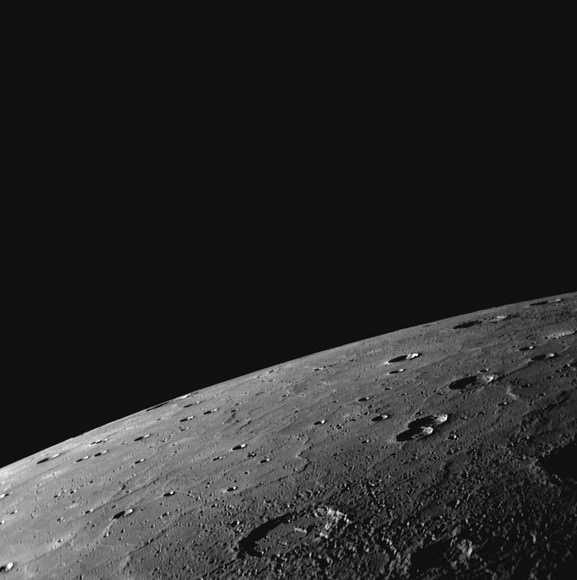[/caption]
When you look at an image of Mercury, it looks like a dry, airless world. But you might be surprised to know that Mercury does have an atmosphere. Not the kind of atmosphere that we have here on Earth, or even the thin atmosphere that surrounds Mars. But Mercury’s atmosphere is currently being studied by scientists, and the newly arrived MESSENGER spacecraft.
Mercury’s original atmosphere dissipated shortly after the planet formed 4.6 billion years ago with the rest of the Solar System. This was because of Mercury’s lower gravity, and because it’s so close to the Sun and receives the constant buffeting from its solar wind. Its current atmosphere is almost negligible.
What is Mercury’s atmosphere made of? It has a tenuous atmosphere made up of hydrogen, helium, oxygen, sodium, calcium, potassium and water vapor. Astronomers think this current atmosphere is constantly being replenished by a variety of sources: particles of the Sun’s solar wind, volcanic outgassing, radioactive decay of elements on Mercury’s surface and the dust and debris kicked up by micrometeorites constantly buffeting its surface. Without these sources of replenishment, Mercury’s atmosphere would be carried away by the the solar wind relatively quickly.
Mercury atmospheric composition:
- Oxygen 42%
- Sodium 29%
- Hydrogen 22%
- Helium 6%
- Potassium 0.5%
- With trace amounts of the following:
Argon, Carbon dioxide, Water, Nitrogen, Xenon, Krypton, Neon, Calcium, Magnesium
In 2008, NASA’s MESSENGER spacecraft discovered water vapor in Mercury’s atmosphere. It’s thought that this water is created when hydrogen and oxygen atoms meet in the atmosphere.
Two of those components are possible indicators of life as we know it: methane and water vapor(indirectly). Water or water ice is believed to be a necessary component for life. The presence of water vapor in the atmosphere of Mercury indicates that there is water or water ice somewhere on the planet. Evidence of water ice has been found at the poles where the bottoms of craters are never exposed to light. Sometimes, methane is a byproduct of waste from living organisms. The methane in Mercury’s atmosphere is believed to come from volcanism, geothermal processes, and hydrothermal activity. Methane is an unstable gas and requires a constant and very active source, because studies have shown that the methane is destroyed in less than on Earth year. It is thought that it originates from peroxides and perchlorates in the soil or that it condenses and evaporates seasonally from clathrates.
Despite how small the Mercurian atmosphere is, it has been broken down into four components by NASA scientists. Those components are the lower, middle, upper, and exosphere. The lower atmosphere is a warm region(around 210 K). It is warmed by the combination of airborne dust(1.5 micrometers in diameter) and heat radiated from the surface. This airborne dust gives the planet its ruddy brown appearance. The middle atmosphere contains a jetstream like Earth’s. The upper atmosphere is heated by the solar wind and the temperatures are much higher than at the surface. The higher temperatures separate the gases. The exosphere starts at about 200 km and has no clear end. It just tapers off into space. While that may sound like a lot of atmosphere separating the planet from the solar wind and ultraviolet radiation, it is not.
Helping Mercury hold on to its atmosphere is its magnetic field. While gravity helps hold the gases to the surface, the magnetic filed helps to deflect the solar wind around the planet, much like it does here on Earth. This deflection allows a smaller gravitational pull to hold some form of an atmosphere.
The atmosphere of Mercury is one of the most tenuous in the Solar System. The solar wind still blows much of it away, so sources on the planet are constantly replenishing it. Hopefully, the MESSENGER spacecraft will help to discover those sources and increase our knowledge of the innermost planet.
We have written many articles about Mercury’s atmosphere for Universe Today. Here’s an article about how magnetic tornadoes might regenerate Mercury’s atmosphere, and here’s an article about the climate of Mercury.
If you’d like more information on Mercury, check out NASA’s Solar System Exploration Guide, and here’s a link to NASA’s MESSENGER Misson Page.
We have also recorded an entire episode of Astronomy Cast all about atmospheres. Listen here, Episode 151: Atmospheres.
References:
NASA: Atmosphere of Mercury
NASA Solar System Exploration
Wikipedia
Nature.com

